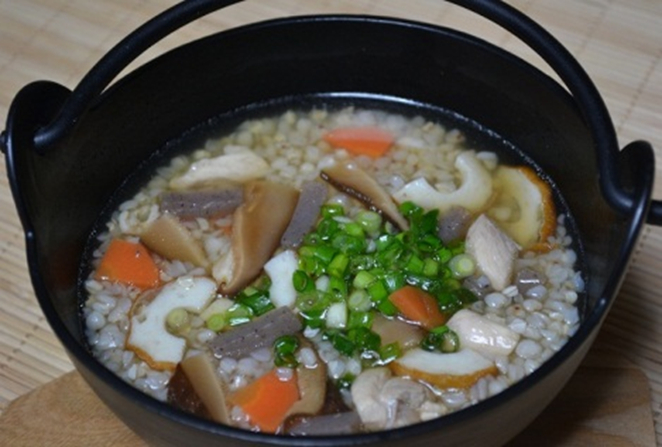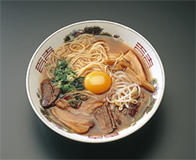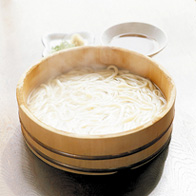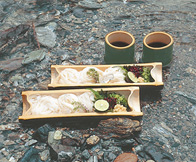文字サイズ
Tokushima Prefecture
Sobagome are buckwheat seeds and are first boiled in salted water, then their skin is peeled and dried. Buckwheat is used in the form of seeds without being pulverized, which is the characteristic cooking method of Tokushima.
According to the legend, the Taira Clan, who were defeated at the Genpei War and escaped to Iya region, made the original version of the buckwheat porridge for New Year’s Day, remembering the life in Kyoto. Nowadays, buckwheat porridge is well known in the entire area of Tokushima as Tokushima’s local cuisine and commonly eaten by many people.

Barazushi is also called “Gomokuzushi”, “Kakimaze” or “Osumoji”. The cuisine used to be a type of sushi (with a variety of ingredients sprinkled on the rice) for seasonal festivals and used to be made a lot for presents.
Chikuwa (chube-shaped fish paste cake), burdocks, konjac (paste made from konjac flower), carrots, fried tofu, seasonal vegetables and red kidney beans are added. Red kidney beans go very well with sushi rice and are the characteristic of this cuisine.
In some regions of the south of Tokushima, peanuts are added. There is also “Kakimaze” in which juice of yuzu (citrus fruits) is used instead of vinegar for sushi rice.

Wasanbon sugar is made from sugarcane plants called “Taketo”. Sugar which is domestically produced is rare and Wasanbon sugar is made by traditional method in eastern Shikoku. It is said that Maruyama Tokuya (a monk who led an ascetic life in mountains) from Kamiita-cho disseminated it approximately 220 years ago in Tokushima. At the end of 18th century, Tokushima-Han (feudal domain) protected the sugar and Awa Wasanbon Sugar gained its good reputation.
The foothill around Kamiita-cho facing southwards is the most suitable land for sugarcane cultivation and the entire side of the foothill use to be sugarcane fields. Its elegant sweetness and rich flavor are absolutely vital for high-class Japanese sweet shops as a sweetener for their confectionery.

Tokushima Ramen Noodles feature dark brown pork bone soy sauce broth, pork ribs cooked in sweet and salty flavor like Sukiyaki and a raw egg on top. As it has a strong taste, most local people in Tokushima eat the noodles with white rice. Some noodle shops offering old-style light taste broth with white-yellow color are popular, too.
A Tokushima ramen noodle shop opened in the Shinyokohama Raumen Museum in 1999 and since then, Tokushima Ramen Noodles have been well known throughout the whole country.

Tarai Udon Noodles are a specialty in Donari-cho, Itano-gun. In late Edo Period (late 18th century–early 19th century) local lumberjacks used to cook hand-made udon noodles at a mountain stream and eat them directly from the pot, from this Tarai Udon Noodles are said to have originated. Another feature is that noodles are eaten with the broth made of river lizard gobies (small fish of gobies family) inhabiting mountain streams.
It is rustic to eat firm hand-made udon noodles in a big tarai (tub) with lots of people, enjoying the beautiful Miyagouchidani Valley.

Iya region is located in a narrow valley of Iya River, a branch of the Yoshino River running through the deep Shikoku Mountains in the west of Tokushima Prefecture. The temperature changes drastically between the day and night time in the region, and the land is sterile. Buckwheat prefers cold weather and grows in sterile land; therefore, the region has been a good quality land to cultivate buckwheat.
Iya Soba Noodles are a characteristic home cuisine in the mysterious Iya. Thick noodles, in which binding agent is rarely used, have a rough texture and are easily cut, compared with ordinary soba noodles. Eating with light tasting soup enhances soba noodles’ original aroma and flavor.

Handa, Tsurugi-cho in western Tokushima has a suitable climate and natural features to make somen noodles: cold winds blowing down from Shikoku Mountains and abundant quality underground water from the Yoshino River. Approximately 40 traders currently produce somen noodles; therefore, it can be called a “noodle town”.
The characteristics of Handa Somen Noodles are the firm texture and thickness, compared to ordinary somen noodles. Many people say that they want to eat them again. The chewy texture is a real characteristic of Handa Somen Noodles. You can enjoy eating them cold in the classic way. The noodles do not become soft quickly, even if they are cooked; therefore, Nyumen (somen noodles in warm soup) and pasta style dishes are also good options to enjoy them.

Copyright © Tokushima Prefecture, All rights reserved.